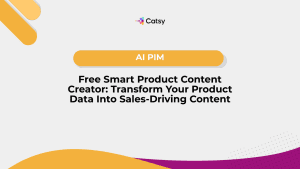PIM Requirements: System Selection Checklist
A Guide to PIM (Product Information Management) Software
- Elizabeth Byrd
- October 7, 2025
- 2:04 pm

Table of Contents
What You'll Learn:
- Essential PIM requirements framework that eliminates 60 percent of unsuitable vendors immediately
- Technical capability checklist preventing costly implementation failures and vendor lock-in
- Integration requirements that ensure seamless data flow across your entire tech stack
- ROI evaluation methods showing how proper selection delivers 3 to 5x returns within 18 months
- Decision-making criteria that future-proof your investment against changing business needs
1. Defining Your PIM Requirements
Why it matters: Digital transformations have accelerated across industries, yet many organizations struggle with implementation because they skipped proper requirements gathering. Without clear requirements, you’ll waste months evaluating wrong solutions for your product information management system.
Start with business objectives rather than features. Define specific pain points your PIM must solve. Document current data volumes, user counts, and channel requirements. Establish measurable success criteria before vendor evaluation begins.
The technical reality: Your requirements become the foundation for vendor selection. Generic feature lists waste evaluation time. Specific requirements immediately eliminate 60 percent of unsuitable platforms.
Data complexity: Modern enterprises manage vast amounts of both structured and unstructured data. McKinsey research shows that while companies have long worked with structured data, generative AI has opened up 90 percent of previously untapped unstructured data, creating new complexity in product information requirements.
User impact: Sales teams need different data access than engineering departments. Marketing requires content creation tools while finance needs pricing controls. Map user roles to specific functionality requirements.
The bottom line: Companies with clearly defined requirements complete PIM selection faster and achieve higher ROI. McKinsey research indicates that fewer than 20 percent of companies have maximized their data transformation potential, often due to inadequate planning and requirements definition.
2. Core System Capabilities Assessment
System requirements: Your PIM must handle current data volumes plus three times growth without performance degradation. Cloud-native architectures scale automatically while legacy systems require costly hardware upgrades.
Focus on data modeling flexibility. Configure custom attributes, categories, and hierarchies matching your product structure. Rigid systems force artificial data constraints that limit business agility.
Workflow changes: Manual spreadsheet processes give way to automated validation, approval workflows, and quality scoring. Initial learning curves pay dividends through reduced errors and faster processing.
Data governance becomes essential at scale. Built-in validation rules prevent bad data entry. Role-based permissions control who can create, edit, and publish information. Audit trails track every change for compliance purposes.
The technical reality: Modern PIMs should support both structured and unstructured data. Technical specifications need different handling than marketing descriptions. Multi-format content requires flexible storage approaches.
Integration challenges: Legacy systems often lack modern API capabilities. Evaluate pre-built connectors for your ERP, DAM, and e-commerce platforms. Custom integration costs can exceed PIM license fees.
ROI breakdown: Successful data transformations can yield enormous benefits, with leading institutions seeing 15-25 percent bottom-line improvements when proper workflow automation and validation controls are implemented.
3. Integration and Technical Requirements
API limitations: Not all APIs handle high-volume data synchronization. Real-time updates require robust API architectures with proper error handling and retry mechanisms.
Evaluate native integrations with your existing tech stack. ERP systems need bidirectional product and pricing synchronization. E-commerce platforms require automated catalog updates. DAM systems must handle digital asset relationships.
Migration considerations: Data migration complexity determines implementation timeline and costs. Clean, structured source data migrates easily. Scattered, inconsistent data requires extensive cleanup before migration.
Scalability factors: Cloud-native platforms automatically scale with usage. Traditional systems require manual capacity planning and hardware investments. Consider future growth when evaluating architecture approaches.
System requirements: Your infrastructure must support chosen deployment models. Cloud solutions need reliable internet connectivity. On-premise deployments require internal IT expertise and hardware maintenance.
What’s next: Edge computing and distributed architectures become important for global operations. Multi-region data residency requirements impact platform selection for international businesses.
Between the lines: Integration capabilities often determine long-term success more than core PIM features. Understanding how to choose the best PIM software buying approach prevents costly architectural mistakes.
4. Evaluating Vendor Support and ROI
By the numbers: Worldwide IT spending is expected to reach $5.74 trillion in 2025, with significant investment in AI-related projects including product information management solutions.
Track implementation timelines and support quality. Vendor expertise significantly impacts project success rates. Look for industry-specific experience and customer references in similar business contexts.
ROI breakdown: Proper vendor selection delivers measurable returns through faster implementation, reduced customization costs, and ongoing platform optimization support.
Go deeper: Total cost of ownership extends beyond license fees. Implementation services, training costs, and ongoing support significantly impact long-term value. Calculate 3-5 year TCO for realistic comparisons.
Compliance requirements: Industry-specific regulations influence vendor selection. Healthcare requires HIPAA compliance. Manufacturing needs safety standard support. Financial services demand audit trail capabilities.
The big picture: McKinsey research shows that successful digital transformations require both broad and deep organizational change, with properly aligned PIM solutions and strong vendor support being critical success factors.
User impact: Vendor training programs and change management support directly correlate with user adoption rates and project success metrics.
5. Making Your Final Selection Decision
Driving the news: Modern organizations increasingly adopt cloud-native, API-driven platforms as businesses embrace composable architectures, according to Gartner’s Product Information Management market analysis.
Implementation timeline: Realistic deployment schedules prevent rushed decisions. Complex customizations extend timelines while standardized approaches accelerate value realization.
The technical reality: Proof-of-concept testing with real data reveals platform limitations before contract commitment. Many vendors offer trial periods for hands-on evaluation.
What’s next: AI-powered content generation and automated enrichment become standard features. Future-ready platforms integrate machine learning capabilities rather than treating them as add-ons.
Workflow changes: Selection committees should include all stakeholder departments. IT evaluates technical requirements while business users assess functionality and usability factors.
The bottom line: Systematic evaluation processes prevent costly selection mistakes. Document decision criteria and vendor scores for transparent, defensible platform choices.
Between the lines: The cheapest option rarely delivers the best value. Focus on long-term capability alignment rather than initial cost comparisons.
Key Takeaways
Requirements First: Define specific business objectives, data complexity, and user needs before evaluating vendor features. Clear requirements eliminate unsuitable platforms immediately.
Integration Critical: API capabilities and pre-built connectors determine implementation success more than core PIM functionality. Evaluate technical compatibility thoroughly.
Vendor Partnership: Strong implementation support and ongoing platform development investment provide better long-term value than lowest-cost options.
Future-Ready: Choose scalable, cloud-native architectures with AI capabilities and composable design patterns to avoid costly migrations as business needs evolve.
Consider multi-store architecture when you are facing significant regional product variations. Complex compliance requirements and distinct customer segments should also be considered.
Typically, manufacturing businesses will benefit from multi-store approaches. This is especially true if you’re serving markets with different safety standards or regulatory requirements. Remember, too, that business-to-business and business-to-consumer customers will have fundamentally different purchasing processes.
Effective inventory management requires integration between your stores and your legacy systems. This usually involves middleware solutions.
You can synchronize your stock levels, coordinate fulfillment, and manage your regional allocation strategies. The key lies in maintaining real-time visibility across each of your channels while enabling flexible fulfillment.
The primary challenges you may face include management of safety standards, tech documentation, and environmental regulations. Proper customs and import documentation may also come into pay.
Each market may require different certifications, testing procedures, and ongoing compliance monitoring, and these must be integrated into your multi-store operations.
The primary challenges you may face include management of safety standards, tech documentation, and environmental regulations. Proper customs and import documentation may also come into pay.
Each market may require different certifications, testing procedures, and ongoing compliance monitoring, and these must be integrated into your multi-store operations.
FAQs:
How long should PIM requirements gathering take?
A comprehensive gathering of all the necessary information will usually take between four to six weeks. This includes collecting input from your stakeholders: IT, marketing, sales, and operations teams should be included! Rushing this phase often leads to costly selection mistakes.
What's the most critical PIM requirement to evaluate first?
The flexibility of data modeling determines whether a platform can adapt to your product structure. Rigid schemes may force artificial constraints – a square peg into a round hole, so to speak – that can limit your future growth.
Should technical requirements outweigh business functionality?
You should aim to balance both equally. The best business features become worthless without the proper tech integration. Perfect tech capabilities mean nothing if the people using them can’t accomplish their goals.
How many PIM vendors should be included in detailed evaluation?
Narrow your options down to three or four finalists after an initial screening for your most basic requirements. Detailed evaluation of too many options will just waste time, and too few will limit your competitive comparison.
What's the biggest selection mistake organizations make?
Choosing based on feature lists rather than business requirements alignment. Many platforms offer similar features but they differ significantly in both their implementation approach and their long-term scalability.
Elizabeth Byrd
Consider multi-store architecture when you are facing significant regional product variations. Complex compliance requirements and distinct customer segments should also be considered.
Typically, manufacturing businesses will benefit from multi-store approaches. This is especially true if you’re serving markets with different safety standards or regulatory requirements. Remember, too, that business-to-business and business-to-consumer customers will have fundamentally different purchasing processes.
Effective inventory management requires integration between your stores and your legacy systems. This usually involves middleware solutions.
You can synchronize your stock levels, coordinate fulfillment, and manage your regional allocation strategies. The key lies in maintaining real-time visibility across each of your channels while enabling flexible fulfillment.
The primary challenges you may face include management of safety standards, tech documentation, and environmental regulations. Proper customs and import documentation may also come into pay.
Each market may require different certifications, testing procedures, and ongoing compliance monitoring, and these must be integrated into your multi-store operations.
The primary challenges you may face include management of safety standards, tech documentation, and environmental regulations. Proper customs and import documentation may also come into pay.
Each market may require different certifications, testing procedures, and ongoing compliance monitoring, and these must be integrated into your multi-store operations.





